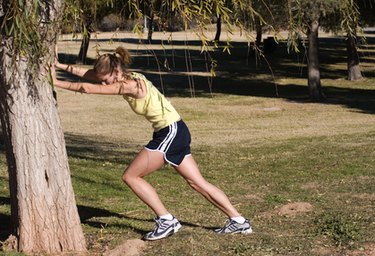
The human body is capable of a wide range of movement. This movement occurs in the various areas of the body including the spine and extremities. Range of motion refers to the amount of movement that a particular joint or body part can move measured in degrees. Injuries to muscle, ligaments or bone can impair range of motion, which is commonly assessed after an orthopedic injury. All areas of the body have specific ranges of motion.
Measurement
Video of the Day
Range of motion can be assessed as a visual estimation, by handheld instrument or by a computer-controlled inclinometer. Doctors who treat patients with musculo-skeletal pain and injury test range of motion to determine if an injury has occurred in a specific joint. According to the text "Orthopedic Physical Assessment," during an examination two types of range of motion tests are commonly performed. These measure active and passive range of motion. Active range of motion refers to movements done by the patient, such as tucking the chin to the chest. Passive range of motion refers to motions carried out by the doctor or therapist, such as the doctor moving the patient's head without help from the patient.
Video of the Day
Areas Commonly Tested for Range of Motion
Range of motion is commonly tested in the cervical spine, thoracic spine and lumbar spine. In many sports medicine clinics, range of motion in the upper and lower extremities are also tested. The measured degrees are compared with the expected norm and also from a healthy joint with an injured joint. After a treatment series, range of motion is tested again for functional improvement in the care plan.
Cervical and Thoracic Spine Ranges of Motion
The cervical spine is made up of the seven bones in the neck. At the lower portion of the neck, the spine curves backwards (kyphosis) and becomes the thoracic spine. The thoracic spine consists of the 12 thoracic vertebra and the ribs located on each side. When checking cervical range of motion, the examiner tests the movement of the head, or skull, and neck in flexion, extension, lateral bending and rotation. Normal ranges of motion for the cervical spine include 50 degrees of flexion, 60 degrees of extension, 45 degrees of lateral, or side bending, and 80 degrees of rotation. The ranges of motion for the thoracic spine include 30 degrees of rotation and 50 degrees of kyphosis.
Low Back Ranges of Motion
The lumbar spine, commonly known as the low back, is also tested during range of motion exams. The lumbar spine has five vertebrae and connects the spine to the pelvis. Normal lumbar ranges of motion include 60 degrees of flexion, 25 degrees of extension, and 25 degrees of lateral, or side, bending.
Upper Extremity Ranges of Motion
The upper extremity has multiple joints and the total range of motion is a combination of all of these joints working together. The text "Examination of Orthopedic and Athletic Injuries," notes that a deficit in one joint affects the motion in the others. Common upper extremity ranges of motions for the shoulder include 170 to 180 degrees of flexion, 50 to 60 degrees of extension, 170 to 180 degrees of abduction for moving the arm away from the body, 80 to 90 degrees of internal rotation, and 90 to 100 degrees of external rotation. Ranges of motion in the elbow and forearm include 90 degrees of supination and pronation, or rotating the forearm. It also includes 145 to 155 degrees of elbow flexion and 0 degrees of extension due to the bony anatomy of the joint. Hyper-extension can occur from injury. Wrist range of motion includes 80 to 90 degrees of flexion and 75 to 85 degrees of extension.
Lower Extremity Ranges of Motion
Lower extremity ranges of motion for the hip include 120 to 130 degrees of flexion, 10 to 20 degrees of extension, 45 degrees of abduction away from the body, 30 degrees of adduction toward body, 45 degrees of internal rotation, and 50 degrees of external rotation. Knee range of motion consists of the flexion and extension arc of motion which totals 135 to 145 degrees. Ankle range of motion includes 50 degrees of plantar-flexion, or toes pointing toward the ground, and 20 degrees of dorsi-flexion with the toes pointing toward head. It also includes 20 degrees of inversion and 5 degrees of eversion.
Loss of Range of Motion
The human body requires all joints move through a full range of motion to function correctly. Reduced range of motion can occur if damage occurs to the soft tissues of the spine or extremities, the lumbar discs, or if weak or tight muscles affect the posture of the individual.
Is this an emergency? If you are experiencing serious medical symptoms, please see the National Library of Medicine’s list of signs you need emergency medical attention or call 911.